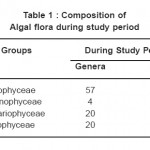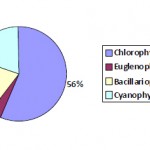Biodiversity of Algae in River Narmada at Hoshangabad
Pramod Patil1 * , R.K. Raghuwanshi2 and Alka Verma3
1
Govt. Narmada Mahavidyayala,
Hoshangabad,
Bhopal,
India
2
Government MLB (Auto.)Girls P.G. College,
Bhopal,
India
3
Government Sarojani Naidu (Auto) Girl’s P.G. College,
Bhopal,
India
DOI: http://dx.doi.org/10.12944/CWE.6.1.12
The present paper communicates the species richness of algae in river Narmada. The relative contribution of these primary producer groups to the total photosynthetic production of organic matter in rivers is undetermined. The present work is an effort to determine the range of variation among different groups of algae. Composition of algal flora comprises Chlorophyceae (56%), Euglinophyceae (4%), Bacillariophyceae (20%), and Cyanophyceae (20%). Chlorophyceae were reported maximum (128 sp.) during the study period.
Copy the following to cite this article:
Raghuwanshi R.K, Patil P, Verma A. Biodiversity of Algae in River Narmada at Hoshangabad. Curr World Environ 2011:6(1);91-93. DOI:http://dx.doi.org/10.12944/CWE.6.1.12
Copy the following to cite this URL:
Raghuwanshi R.K, Patil P, Verma A. Biodiversity of Algae in River Narmada at Hoshangabad. Curr World Environ 2011:6(1);91-93. Available from: http://www.cwejournal.org/?p=1285
Download article (pdf)
Citation Manager
Publish History
Select type of program for download
| Endnote EndNote format (Mac & Win) | |
| Reference Manager Ris format (Win only) | |
| Procite Ris format (Win only) | |
| Medlars Format | |
| RefWorks Format RefWorks format (Mac & Win) | |
| BibTex Format BibTex format (Mac & Win) |
Article Publishing History
| Received: | 2011-04-12 |
|---|---|
| Accepted: | 2011-06-17 |
Introduction
Algae are major producer of organic compounds. It has an important position in aquatic food chain. Since algae indicate the levels of pollution in water bodies as bio indicator and it also helps to determine the quality and conservation of water (Palmer, 1980), but not much attention has been paid with reference to their occurrence and distribution in different lotic and lentic water bodies. India is a land of many rivers. Narmada is prominent river of Madhya Pradesh. It is supposed to be the lifeline of the state but due to expanding needs of growing population river Narmada is facing many adversities or changes. In India, the studies on reverine ecosystems have attracted the attention of quite a few investigators in last few decades, e.g. Roy (1955), Choko and srinivasan (1955), Kudesia and Sharma (1981) and Mathur (1990). The river Narmada has received little attention from botanists, ecologists and specially algologists as such and moreover the scientific approach was not holistic. Even in dealing with the floristic pattern, habitats of various algal groups were overlooked. Algae play an important role to purify the water by photosynthesis. In other words it helps in the process of rejuvenation of rivers (Sharma. 2005).
However, industrialization has also posed threat to water quality by effluent discharge and sewage disposed in rivers. This has led to eutrophication of rivers and change in ecosystem of rivers. In the present study algal flora of river Narmada was studies and the biodiversity was measured.
Materials and Methods
The hydro biological study of river Narmada at Hoshangabad has been done for twenty four months from November 2002 to October 2004. (A.P.H.A., 1992, Adoni et al. 1985). During the study the algal samples were identified with the help of standard books and monographs. (Fritsch, 1935; Prescott, 1982; Deshikachary, 1985 and Philipose, 1967).
Results
A total 209 algal taxa belonging to 101 genera have been colleted and identified from different session. The number of various member of class Chlorophyceae (128 taxa), Euglinophyceae (13 taxa), Bacillariophyceae (35 taxa) and Cyanophyceae (33 taxa) are as shown in Table 1 and Fig.
 |
Table 1: Composition of Algal flora during study period Click here to View table |
 |
Figure 1: Composition of Algal flora during study period Click here to View figure |
Discussion
The present investigation showed that the monthly variation of the algal population were highly fluctuated at different stations during the study periods. The physicochemical factors affected the distribution and periodicity of algae in different seasons. During Monsoon River do not support algal biota due to high water currents. The trends of various groups of algae in river Narmada showed that the lowest population were observed during rains, more in winters and maximum during summer as also suggested by Pahawa and Meharotra, 1966.
Species of Chlorophyceae were maximum in early summer (March) while the species of Cyanophyceae were highest in late summer (June). However Euglinineae are rarely found in fast flowing water (kumble and Tayade, 2001) but few species were observed in early winters (October). Similarly, members of Bacillariophyceae were dominated during late winter i.e. December (Mathur, 1990).
Thus, the algal spectrum of river Narmada showing the oligotrophic nature at cer tain sites and due to dominance of filamentous green algae, the river Narmada can be classified under. “Zygnema type of river” (Blum, 1956). Due to anthropogenic activities nearby sites of river Narmada at Hoshangabad are badly polluted. At polluted sites (St. II and St. Ill) a large number of algae tolerating organic pollution were reported, mostly belonging to Chlorococcales, Euglinoids, Desmids and few members of Cyanophyceae (Kapoor, et al 1992; and Bowling, 1994). Finally the river water enters in Hoshangabad town receives wastes from various sources, thereby reducing the algal form. The river is subjected for careful management to restrain further degradation.
Change in ecosystem of rivers. In the present study algal flora of river Narmada was studies and the biodiversity was measured.
Referenecs
- A.P.H.A., Standard Methods for the examination of water and waste. American Public Health Association, New York (1992).
- Adoni, A.D. Joshi, G. Ghosh, K. Chourasia, S.K. Vaishya, A.K. Yadav, M. and Verma, H.G., Work on Limnology, Pratibha Publishers, Sagar. 1-216 (1985).
- Blum, J.L., The ecology of river algae. Bot. Rev., 22: 291-234 (1956).
- Chacko, P.I. and Srinivasan, R., Observation on hydrobiology of the major river of Madras State, South India, Cortr. Fresh Biol. Stn. Madras, 13: 1-16 (1955).
- Desikachary, T.V., Cyanophyta, I.C.A.R., New Delhi (1959).
- Fritsch, F.E., Structure and reproduction of the algae Vol. I and II. Cambridge University Press Cambridge (1935).
- Kudesia, V.P. and Sharma, S., Physicochemical Characteristics of river Kali Nadi at Meerut. IAWPC Tech. Allual 8: 168 (1981).
- Kapoor K. and Solanki, P.S., Water management problems related to water resources of Udaipur (Raj.) India. In Proc. of Nat. Sem. on Environ protection from industrialization, Gupta, R.S. and Kapoor, K. (Eds.) MLS University Udaipur: 119-126 (1992).
- Mathur, M., An ecological study of the algal flora of the river Narmada at Hoshangabad. Ph.D. thesis (1990).
- Prescott, G.W., Algae of the western Great Lake Area W.M.C. Brown publ. Debuque IOWA. 1-997 (1982).
- Philipose, M.T., Chlorococcales. I.C.A.R.. New Delhi (1967).
- Palmer, CM., Algae and water Pollution Castle house publication Ltd., U.S.A., 1-123 (1980).
- Roy, H., Plankton ecology of river Huoghli (West Bengal) Ecology 36: 169-175 (1955).
- Sharma. P.D., Environmental Biology and Toxicology. 290-91 (2005).
- Bowling. L., Occurrence and possible cause of severe Cyanobacterial blooms in lake Cargelligo. New South Wales; In Cyanobacterial Research in Australia. G. Jones (Ed.): 1-197 (1994).






